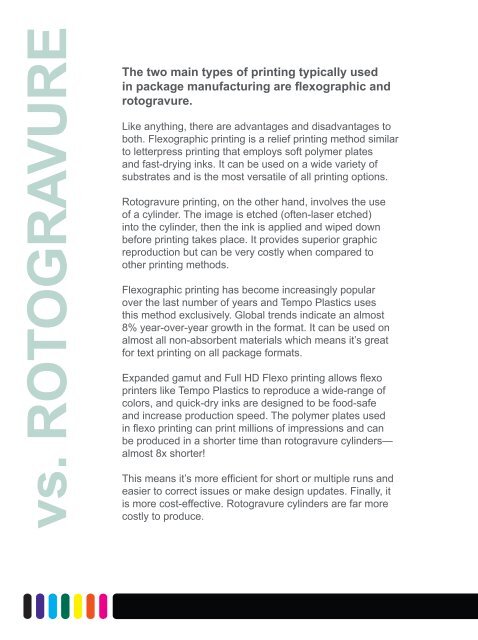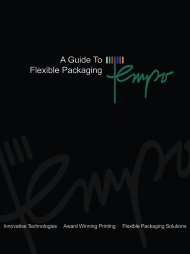A Guide To Flexographic Printing
You also want an ePaper? Increase the reach of your titles
YUMPU automatically turns print PDFs into web optimized ePapers that Google loves.
vs. ROTOGRAVURE<br />
The two main types of printing typically used<br />
in package manufacturing are flexographic and<br />
rotogravure.<br />
Like anything, there are advantages and disadvantages to<br />
both. <strong>Flexographic</strong> printing is a relief printing method similar<br />
to letterpress printing that employs soft polymer plates<br />
and fast-drying inks. It can be used on a wide variety of<br />
substrates and is the most versatile of all printing options.<br />
Rotogravure printing, on the other hand, involves the use<br />
of a cylinder. The image is etched (often-laser etched)<br />
into the cylinder, then the ink is applied and wiped down<br />
before printing takes place. It provides superior graphic<br />
reproduction but can be very costly when compared to<br />
other printing methods.<br />
<strong>Flexographic</strong> printing has become increasingly popular<br />
over the last number of years and Tempo Plastics uses<br />
this method exclusively. Global trends indicate an almost<br />
8% year-over-year growth in the format. It can be used on<br />
almost all non-absorbent materials which means it’s great<br />
for text printing on all package formats.<br />
Expanded gamut and Full HD Flexo printing allows flexo<br />
printers like Tempo Plastics to reproduce a wide-range of<br />
colors, and quick-dry inks are designed to be food-safe<br />
and increase production speed. The polymer plates used<br />
in flexo printing can print millions of impressions and can<br />
be produced in a shorter time than rotogravure cylinders—<br />
almost 8x shorter!<br />
This means it’s more efficient for short or multiple runs and<br />
easier to correct issues or make design updates. Finally, it<br />
is more cost-effective. Rotogravure cylinders are far more<br />
costly to produce.



